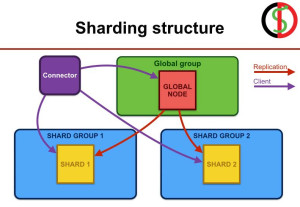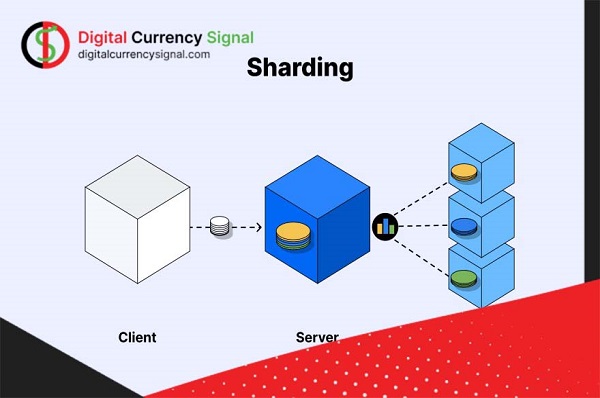Sharding is one of the possible scaling solutions in blockchain, which divides the computing load and data storage into smaller units to increase network speed and capacity. Despite the major implementation challenges, this solution has the potential to overcome the “three-dimensional” challenge. With the birth of sharding, it is as if a path has been opened for blockchain developers to increase the scalability of their projects while maintaining security and decentralization.
What is sharding?
Sharding is a partitioning technique used in a peer-to-peer (P2P) network to distribute the computation and storage load so that each node is not responsible for handling the transaction load for the entire network. Instead, each node only stores information about its partition or parts of a partition. The word shard means a piece or part, and sharding means to break something. In other words, sharding means dividing a large process into smaller processes. Information from each block can still be shared with other nodes, and the ledger is secure and distributed as each node can view and verify each ledger’s records.
Sharding in the realm of blockchain projects means breaking large tables of data into more manageable pieces, called chunks. Each piece has the data that distinguishes it from the others and makes it unique. Sharing has the potential to reduce latency and avoid data overload. The best example to explain sharding is the Ethereum network. Sharding divides the entire network of a blockchain company into smaller parts, each part consisting of its data.
How does sharding work?
Given the definition of sharding and the issues of scalability, you probably already have an idea of the extent to which this technology is used in the world of digital currencies. Sharing in a blockchain network means dividing large data into many smaller pieces and storing it in many databases. Blockchain networks are large databases where there is a node that acts as a separate server in the network. With the implementation of sharding in the blockchain ecosystem, the network is divided into smaller components called “shards”. Each shard in the network maintains a unique set of smart contracts and account balances.

Nodes are placed in different shards to be able to verify operations and services. That is, the nodes on the blockchain are no longer responsible for confirming all transactions. For example, the powerful Ethereum blockchain consists of thousands of computers called nodes. Each of these nodes provides a certain amount of hashing to the network so that the Ethereum virtual machine can perform its tasks.
Ethereum works in a linear execution where every node has to process all operations and transactions. This process takes a lot of time and currently, Ethereum can confirm about 13 transactions per second. In contrast, the Visa payment system can process 24,000 transactions per second. The partitioning technology operating system changes the linear model in which each node is responsible for processing all events to the same mode of execution. In this model, each node is responsible for processing a certain number of transactions, which means that transactions will be processed in parallel and in several rows.
Sharing on the blockchain
Sharding is a database layer used to increase efficiency and scalability in blockchains so that blockchains can process more transactions per second. In effect, sharding divides the entire blockchain network into smaller classes, each called “shards”. On the other hand, each shard has its data, which makes it separate and independent from other shards. Also, the main purpose of sharding in the blockchain is to reduce the delay in information processing and increase its speed.
On the other hand, there are security issues associated with the use of sharding in the blockchain; For example, shard capture or capture is a type of attack where a shard attacks another shard, causing it to lose its data. To understand the mechanism of sharding, we must first understand concepts such as distributed ledger technology (decentralized edge) and scalability.
Distributed Ledger
The use of distributed ledger technology (DLT) on the blockchain makes it attractive; Because it enables mutual agreement in different parts of the world. By recording the events, the data is copied and sent online in a few seconds and shared with the public, forming what is known as public evidence. If part of the network is compromised with this technology or attacked by vandals, network participants can identify what changes and corruptions the vandals have made; Because they all keep a copy of the transaction published on the ledger in their system.
As a result, a distributed transaction system implemented on the blockchain can help reduce fraud and limit the damage caused by cyberattacks and hacking.
Scalability of blockchains
One of the main problems with blockchain technology is that as network users increase and more transactions are processed, network problems occur and data processing slows down, which is called network latency. Latency is considered a barrier to blockchain and limits its application; While blockchains face an obstacle known as delays in the scaling process, existing centralized electronic payment systems operate faster and more efficiently.

In other words, as more and more industries and users adopt this technology, scalability is a challenge for blockchain to handle the growing volume of data and transaction streams. Also, one of the solutions considered to provide seamless scalability is the partitioning process. Sharding is designed to distribute network workloads to reduce latency more efficiently and allow the blockchain to process more transactions in less time.
Conclusion
Sharding is one of the best methods introduced to solve blockchain network scalability problems. Based on this method, the blockchain network is divided into small parts, each of which is called a shard. According to this structure, all transactions sent to the network are split between different shards, thereby increasing the speed of transactions.
So far, many methods have been proposed to solve the blockchain scalability problem; But these methods were temporary and associated with many problems. Although the sharding process also faces challenges, it can be introduced as one of the best available solutions today.



